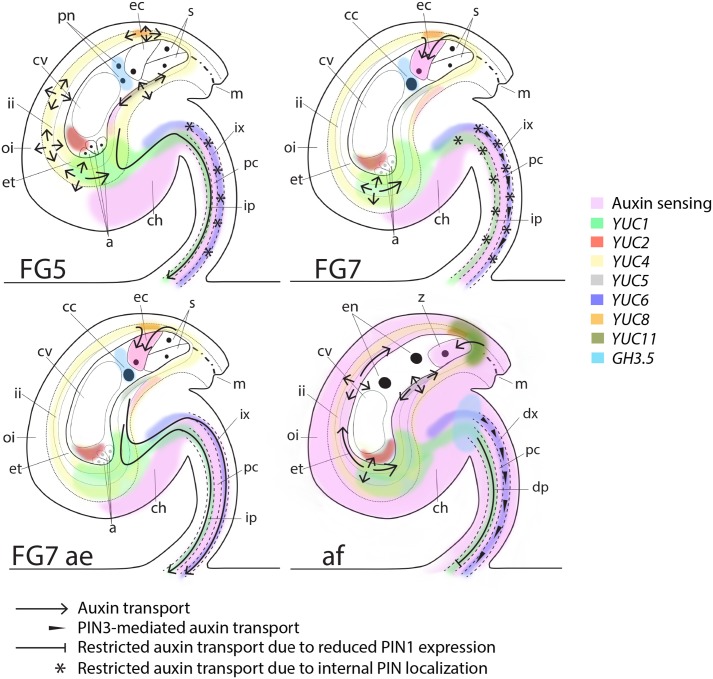FIGURE 5.
Schematic map of auxin sensing, biosynthesis, conjugation and transport at pre-anthesis, anthesis, after emasculation and after fertilization. At the pre-anthesis stage (FG5), auxin biosynthesis, as observed by YUC expression, occurs in the inner integuments, the female gametophyte and in the funicular provasculature (pc; procambium, ip; immature phloem and ix; immature xylem). However, auxin sensing is low in the integuments and in the female gametophyte, presumably due to PGP-mediated auxin transport around the embryo sac (arrows; Lituiev et al., 2013), GH3.5-mediated auxin conjugation in the female gametophyte and PIN-mediated auxin efflux through the immature phloem of the funiculus (arrow). At this stage PIN1, PIN3 and PIN6 are all internally localized in the immature xylem (stars), presumably preventing basal auxin transport in this cell file. At anthesis (FG7), auxin sensing remains low in the integuments and the female gametophyte, but the egg cell starts sensing auxin, which presumably is delivered by AUX1 (Panoli et al., 2015) from the surrounding tissues (arrows). Auxin transport through the immature phloem in the funiculus is repressed by internalization of PIN1 (stars), while basal transport is slightly induced in the immature xylem by increased polarization of PIN3 (arrowheads). If the flowers are emasculated before anthesis (FG7 ae), polar auxin transport through the funicular provasculature is stimulated by basal polarization of PIN1 and PIN6 (arrows), while auxin biosynthesis and auxin sensing in ovules remain unchanged compare to in ovules of non-emasculated flowers. Shortly after fertilization (af), auxin sensing increases drastically throughout the sporophytic tissues of the ovule. Auxin biosynthesis increases in the micropylar end of the integuments through YUC5 and YUC11 activation, while GH3.5-mediated auxin conjugation decreases in the endosperm and increases in the apical part of the funiculus. Auxin transport in the differentiating phloem (dp) in the funiculus is restricted through reduced PIN1 expression levels (blocked arrow) and in the differentiating xylem (dx) through reduced PIN1 and PIN6 expression levels. PIN3, however, remains expressed and basally localized in the dx, presumably retaining a certain level of auxin transport in this cell file (arrowheads). In addition, PIN3-mediated auxin transport is induced in the integuments (arrows), presumably to facilitate the spreading of auxin throughout the sporophytic tissues. PIN3 is also expressed and basally localized in cell file 4 of the funiculus throughout all analyzed stages. This suggests that PIN3-mediated auxin transport in the cell file between the differentiating phloem and the differentiating xylem is not important for the changes in ovule development from before anthesis to after fertilization and is therefore not indicated in the model.

